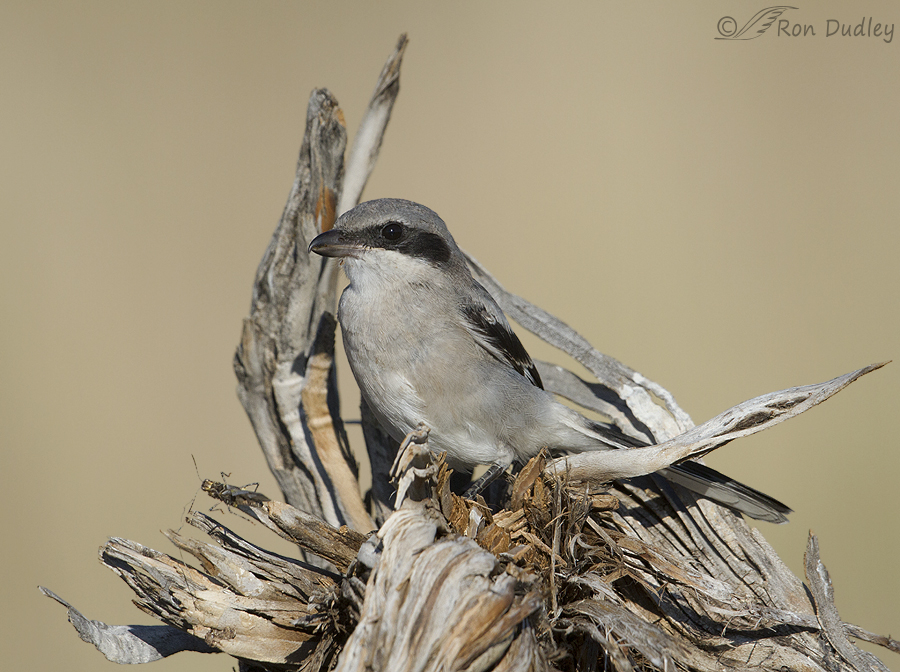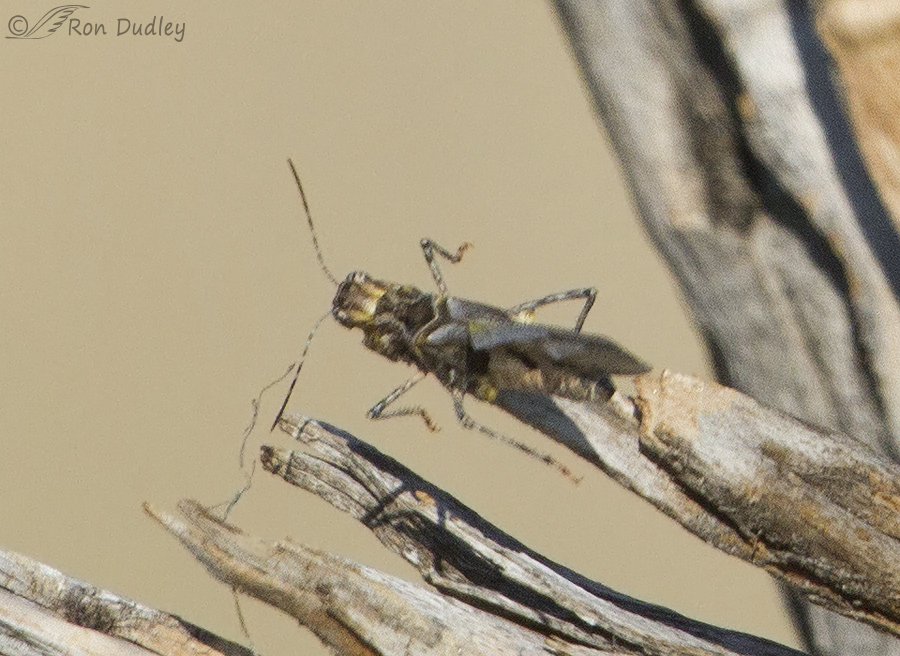I make every effort in the field to “read” the behavior of my avian subjects. Sometimes I’m right and sometimes I’m not but either way it’s a learning experience for me and my percentage of accuracy does seem to be improving. One of the payoffs can be better bird photographs for a variety of reasons.
This image is not one of those “better” photographs but I think it illustrates my point.

1/4000, f/6.3, ISO 500, Canon 7D, Canon EF500mm f/4L IS II USM +1.4 tc, not baited, set up or called in
This gnarly and weathered old sagebrush trunk is a habitual perch for meadowlarks, thrashers and to a somewhat lesser degree, shrikes. All three species nearly always perch on the top of the vertical piece sticking almost straight up slightly to the left of center but as I passed this juvenile Loggerhead Shrike two days ago (in my pickup) I noticed a couple of things – it didn’t flush as I drove by on the road and it was hunkered down in a somewhat protected cranny of the wood, which I thought was slightly unusual.
So I turned around and slowly approached the shrike, fully expecting it to fly off. But it didn’t and it let me get surprisingly close (this image is cropped very little) without even changing its position on the perch. I immediately wondered if it had a food stash in the stump, shrikes being well-known for impaling food items like grasshoppers and even small rodents on barbed wire, thorns or other sharp projections. I looked through my lens for such a food item but couldn’t see any at the moment, probably because I was mostly concentrating on the process of photography.
It wasn’t until I got home and looked at the images on the screen that I noticed the grasshopper below and slightly in front of the shrike.

A huge crop of the same image reveals some clues as to what was going on. At first I thought the ‘hopper was where it was on its own volition but closer inspection suggests not. Three of its legs are splayed out to the side, it seems to be “plastered” down on the twig and in all of the images I took of the shrike the insects position did not change. Juvenile shrikes are notorious for having to learn the skills of stashing/impaling their food, a process I’ve watched (and photographed) multiple times and believe me it can be amusing because they’re so clumsy at it. They often repeatedly attempt to position the prey on a poorly chosen projection and drop and retrieve it multiple times.
I believe that was what was happening with this grasshopper. I suspect the insect is dead and the shrike had been going through “the learning process” as I pulled up. I only had a few seconds with the bird before a Davis County school bus drove by and flushed the bird (typical bad timing for me…).
All this may seem like much ado about nothing to some but it’s the little things that can add up to interesting photographs and if the school bus hadn’t come by I might have been able to get some interesting behavior shots. And if I hadn’t noticed its unusual position on the perch and its even more unusual “stickiness” as I passed by I’d never have turned around for the bird in the first place.
Just sayin’…
Ron


Great shots! Isn’t it fun to find something you didn’t know was there until you downloaded?
Love it!
Charlotte
Thanks Ron for seeing and helping us see.
I interpreted “little things” as noticing where the shrike was perched and the reluctance to leave it. Those “little” observations are probably more critical for acquiring more of your outstanding images than finding the grasshopper.
Patty, your meaning came through loud and clear, despite the evilness of your iPad. It game me a good laugh.
Too bad you don’t have audio on the new gear…you might have heard what that grasshopper had to say…once I was able to find him, i enlarged the image on the Evil ipad and read his lips. I could just barely make out what he was saying, “Three shrikes and I’m out!”
Love it … when the camera sees what the photographer does not!!! Big fun!!
The ‘little things’ are huge in my world. Small things for small mind? Perhaps, but I get a great deal of pleasure and education from them. And lovely this series of little big things.
Thanks Ron.
“little big things”
I love the way you turn a phrase, Elephant’s Child.
Shrikes are known for skewing their prey, so this image is a great testament to that behavior. Wonderful shots Ron! BTW, I’ve only seen each species of Shrike twice in my life, so you have a great deal of envy from this easterner!!
Thank you, Dick. We have Loggerhead Shrikes galore on the island and a fair number elsewhere in Utah but I’m lucky to spot a Northern Shrike or two as they migrate through in an entire season.
Interesting photo. I did not see the grasshopper you zoomed in on until I looked at the cropped photo. In the original photo the first thing I saw was a grasshopper just in front of the bird’s left foot. It may be learning about stashing, but it is apparently a good hunter.
Susan, Are you saying there’s a second ‘hopper in the image? If so, I can’t see it. Perhaps I’m not as good at spotting the “little things” as I hoped I was…
I thought I was seeing another grasshopper. Maybe the part of the branch near the left foot just has my imagination going really well? After checking several more times, I think it’s my imagination. Nothing wrong with your vision.
Good, that makes me feel better, Susan. I went back and blew that area of the image up and still couldn’t see anything. Thought I’d lost my touch. Or even worse, more of my visual acuity…
I apologize for scaring you, Ron. Loss of visual acuity is an issue for me, too.
Hi Ron,
Wish I had more time to comment on your posts. I enjoy and admire everyone of them. Among the things I admire is your attention to the “little things.” They often end up being the keys to understanding the “big questions.” It’s very heartening these days to know people like yourself are still out there.
Bill Maciejko
Camp Morton, MB
What a nice thing to say, Bill. Thank you very much!
I did find the grasshopper before you showed where. Of course I knew there was a grasshopper there somewhere. Sort of a biologist’s Where’s Waldo. YAY. I think your bird is wondering just how to get that bug where he wants it.
I think your bird is wondering just how to get that bug where he wants it. 
“Sort of a biologist’s Where’s Waldo.”
I enjoyed that line, Arwen.
The nickname “butcher bird” is certainly appropriate for shrikes. I’ve seen shrikes in my local desert (Anza Borrego) with impaled lizards on yuccas. Great shot of a fabulous bird Ron.
You ought to see what these “butcher birds” can do to a vole, Leslie – it isn’t pretty for either the consumer or the “consumee”. Very messy!
I can’t believe I couldn’t see the grasshopper in the first picture. Great educational series. Enjoyed looking at the other phots witht he spider. What a riot!
“I can’t believe I couldn’t see the grasshopper in the first picture.”
And I can’t believe I couldn’t see it through my lens, Ellen – especially since I was actually looking for it!
I saw the grasshopper clearly….-AFTER you told us where and what to look for…i wonder if any of the kids on that bus wondered what you were interested in…and if it sparked some curiosity and interest in them…if so, the interruption wasn’t all bad….
Patty, actually that bus was empty except for the driver so he must have dumped off his load of kids earlier. I looked for them as I drove around the island but didn’t spot them.
Your young shrike certainly appeared to have immobilized his grasshopper! That was a delightful ‘catch’ on your part, and I enjoyed reviewing your former post of a young shrike making multiple attempts to impale a spider on a thorn. Thanks for sharing this bit of daily life of a shrike with us, Ron.
I’m glad you enjoyed the earlier post on this behavior, Alison. I have others too and didn’t know which one to link but I’m happy to hear that this one worked for you.
Ron, both learning how to get food and how to look at photos are both skills we humans have to learn. I would have never seen the grasshopper without your guidance, thanks.
Well, I sure didn’t see it through my lens and I was looking for it, Diana. Thank you.